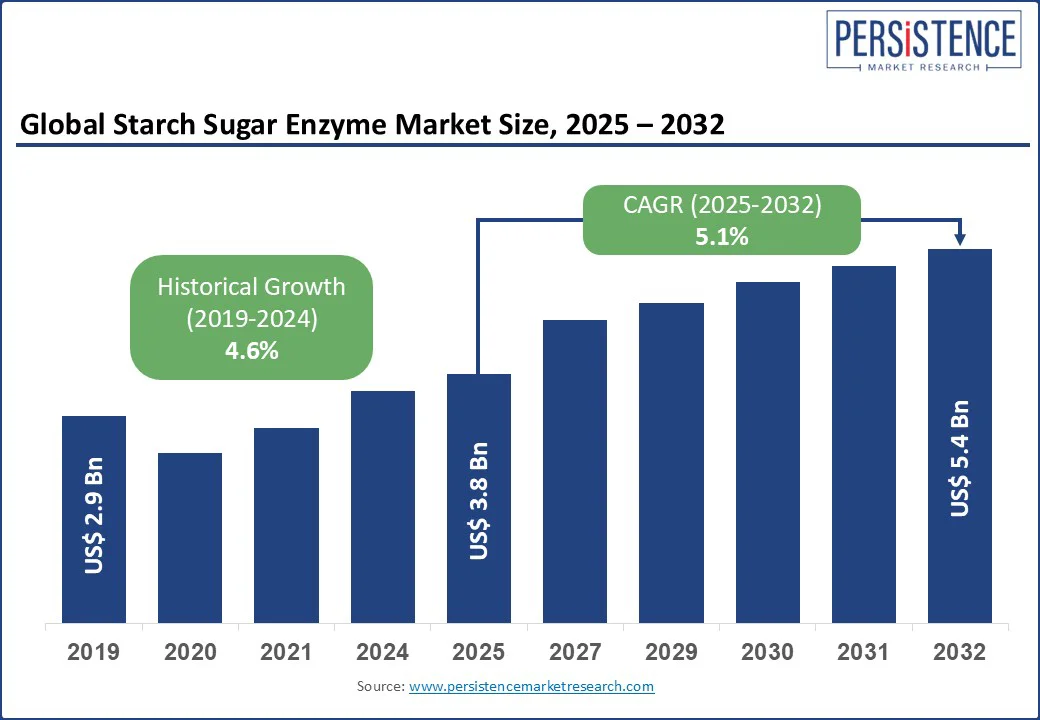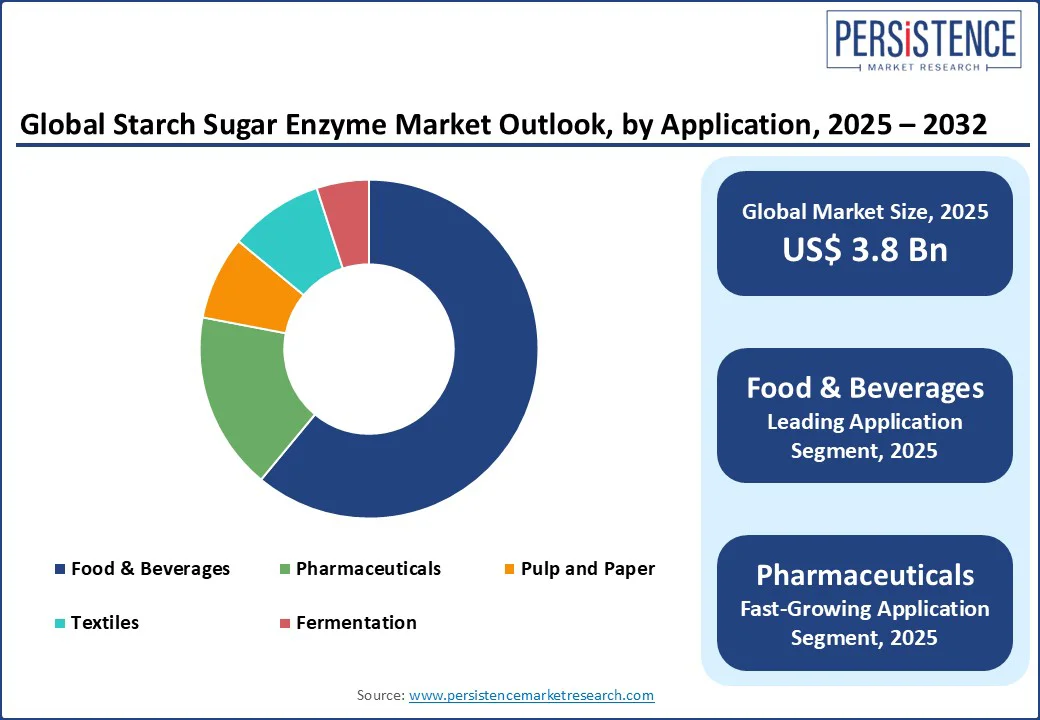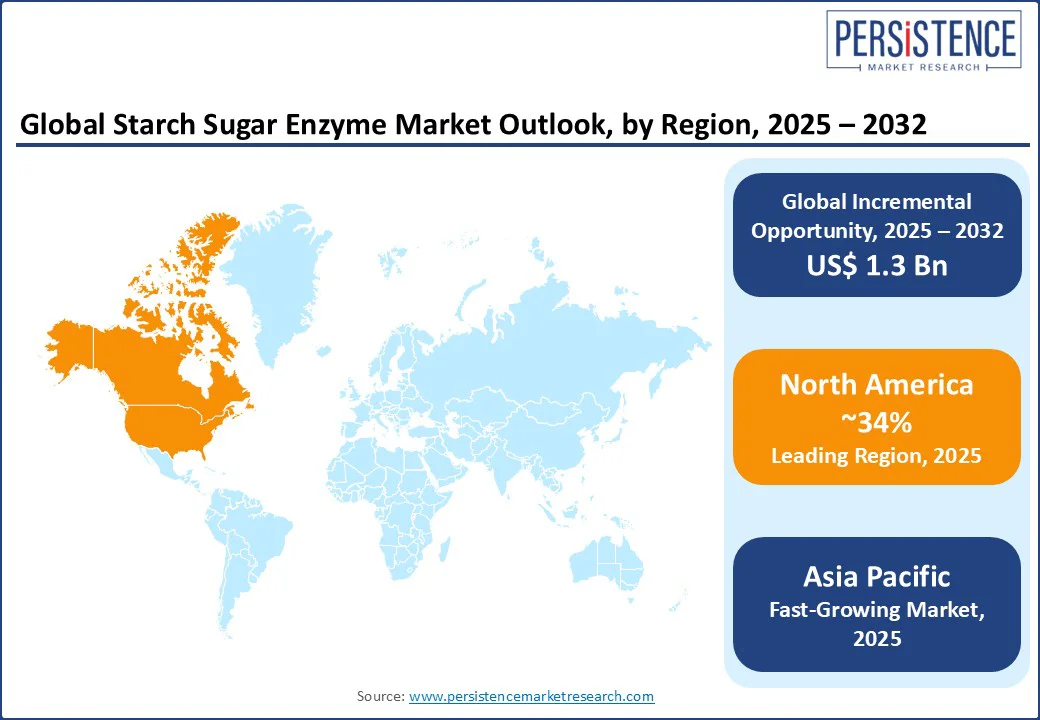ID: PMRREP4538| 196 Pages | 14 Aug 2025 | Format: PDF, Excel, PPT* | Food and Beverages

The global Starch Sugar Enzyme Market is likely to value at US$ 3.8 Bn in 2025 and is expected to US$ 5.4 Bn by 2032, registering a CAGR of 5.1% during the forecast period 2025 - 2032.
The starch sugar enzyme industry was valued at US$ 2.9 Bn in 2019, reflecting steady historical growth supported by the expansion of the global food and beverage industry, increasing demand for bio-based processing solutions, and rising adoption of enzymes in industrial manufacturing.

Key Industry Highlights:
|
Global Market Attribute |
Key Insights |
|
Market Size (2025E) |
US$ 3.8 Bn |
|
Market Value Forecast (2032F) |
US$ 5.4 Bn |
|
Projected Growth (CAGR 2025 to 2032) |
5.1% |
|
Historical Market Growth (CAGR 2019 to 2024) |
4.6% |
The global shift toward sustainability is a central driver of growth in the starch sugar enzyme market, as industries across sectors increasingly transition from traditional chemical-based starch processing to enzyme-driven methods. Enzyme-based processes offer several advantages, including greater efficiency, reduced energy consumption, and significantly lower environmental impact. They operate effectively under milder temperature and pH conditions, minimizing the need for harsh chemicals and thereby reducing operational hazards and wastewater treatment costs.
In the food manufacturing sector, key starch sugar enzymes such as glucoamylases, amylases, and pullulanases play a vital role in converting starch into value-added products such as glucose, maltose, and various syrups. These outputs are essential in producing sweeteners for confectionery, beverages, and baked goods, industries that are witnessing rising global demand.
Government-backed sustainability initiatives further accelerate adoption. In the U.S., the Department of Energy funds projects that enhance industrial enzyme production efficiency, while the European Commission supports bio-refinery development to lower carbon footprints.
The growing integration of enzymes in bioethanol production adds another layer of opportunity, particularly in North America and Brazil, where renewable energy mandates are expanding. Additionally, their increasing use in brewing, dairy, and plant-based beverages helps manufacturers achieve consistent product quality, higher yields, and faster production cycles.
Despite the significant growth potential of the starch sugar enzyme market, high production costs continue to pose a major barrier, particularly in price-sensitive markets across developing economies.
The production process for these enzymes demands advanced fermentation infrastructure, stringent quality control systems, and specialized downstream purification methods, all of which contribute to substantial capital and operational expenditures. These requirements often make enzyme-based solutions less accessible for small and mid-sized producers in emerging markets.
Moreover, the inherent sensitivity of enzymes to temperature fluctuations and pH variations can limit their performance and reduce shelf life, necessitating specialized storage and handling. In industrial applications that involve elevated temperatures, such as certain stages in food processing, brewing, or textile manufacturing, thermostable enzyme variants are needed to maintain activity. The development and production of such advanced variants add further costs.
For instance, according to the U.S. Department of Agriculture (USDA), the production of industrial enzymes, including starch-processing enzymes, requires significant investment in fermentation technology, purification systems, and quality control measures to meet food-grade and industrial standards
As a result, many smaller manufacturers in regions such as Latin America, Africa, and parts of Southeast Asia continue to rely on more affordable chemical alternatives, despite their environmental drawbacks. Compounding the issue is a shortage of skilled technical personnel capable of optimizing enzyme use in industrial processes, which hampers adoption and slows market penetration in these areas.
The diversification of starch sugar enzyme applications beyond traditional food and beverage processing is opening substantial growth opportunities across various industrial sectors.
In the pulp and paper industry, these enzymes are increasingly utilized for fiber modification, which not only enhances product quality but also significantly reduces the need for harsh chemicals, leading to lower environmental impact and improved energy efficiency in production. Similarly, in the textile industry, enzymes play a crucial role in bio-polishing and desizing, providing an eco-friendly alternative to conventional chemical treatments while maintaining fabric quality and durability.
In the pharmaceutical sector, starch sugar enzymes are gaining prominence in drug formulation, particularly for producing active pharmaceutical ingredients (APIs) with enhanced solubility and bioavailability, thereby improving therapeutic outcomes. In fermentation-based manufacturing, they are essential for preparing feedstocks used in the production of bioplastics, organic acids, and specialty chemicals, supporting the shift toward bio-based materials in multiple industries.
The U.S. Department of Energy’s Bioenergy Technologies Office (BETO) actively supports research and development of enzyme-based processing for industrial applications, including biofuels, bioplastics, and specialty chemicals
The rise of e-commerce and direct-to-consumer distribution channels has further boosted market accessibility, allowing small and medium-sized enterprises to obtain high-quality enzymes without relying solely on traditional large-scale distributors. Companies that can deliver cost-effective, application-specific enzyme formulations tailored for small-scale and niche industrial users are well-positioned to capture this emerging demand.
The global starch sugar enzyme market is segmented into Amylases, Glucoamylases, Pullulanases, Pectinases, and Cellulases. Glucoamylases dominate, holding approximately 44.5% of the global Starch Sugar Enzyme market share in 2025, due to their critical role in complete starch hydrolysis and glucose syrup production across multiple applications. These enzymes are essential for producing high-glucose syrups used extensively in confectionery, beverages, and pharmaceutical applications, with the global glucoamylase market demonstrating consistent growth driven by expanding food processing sectors.
Amylases represent the fastest-growing segment, driven by increasing demand in bakery applications and beverage production. These enzymes are essential for complete starch hydrolysis, producing high-glucose syrups used in confectionery, beverages, and pharmaceutical applications. The segment benefits from growing consumer preference for natural sweeteners and the expansion of the functional food market.
By application type, the Starch Sugar Enzyme market is divided into Food & Beverages, Pharmaceuticals, Pulp and Paper, Textiles, and Fermentation. Food & Beverages leads with a 61% share in 2025, driven by extensive use in bakery products, beverages, dairy processing, and confectionery manufacturing.
Pharmaceuticals represent the fastest-growing segment, fueled by increasing use of starch-derived excipients and the growing nutraceutical market. Starch sugar enzymes are crucial for producing pharmaceutical-grade glucose, modified starches, and functional oligosaccharides used in drug formulation and dietary supplements.
The Starch Sugar Enzyme market is segmented into Bacterial, Fungal, Plant, and Animal sources. Bacterial enzymes dominate with a 45.3% share in 2025, driven by their high stability, broad pH range, and cost-effective production through fermentation. In the food & beverage industry, bacterial amylase is expected to find immense application in the production of alcoholic drinks, particularly during the fermentation process, highlighting its versatility.
Fungal enzymes represent the fastest-growing segment, benefiting from their natural origin, excellent performance at moderate temperatures, and growing acceptance in clean-label applications. Fungal-derived enzymes are particularly favored in organic and natural food processing, aligning with consumer preferences for minimally processed products.

In North America, the U.S. dominates the global starch sugar enzyme market, expected to account for 34% market share in 2025, driven by advanced food processing infrastructure and high consumption of processed foods. The region's demand for amylases and glucoamylases is rising, supported by the expanding bakery industry, craft beverage sector, and increasing adoption of enzyme-based processing technologies. Leading companies such as DuPont and Novozymes continue to innovate with sustainable enzyme solutions meeting evolving industry needs.
Consumer preferences are shifting toward clean-label products, driving demand for natural enzyme-based processing solutions. Companies are responding by developing multi-functional enzyme systems that replace traditional chemical additives while maintaining product quality and shelf life. The U.S. FDA's favorable regulatory framework for food enzymes further supports market growth, with streamlined approval processes encouraging innovation and adoption of novel enzyme technologies.
Europe's market is led by Germany, France, and the Netherlands, driven by stringent food safety regulations and a strong emphasis on sustainable processing technologies. Germany holds the largest European market share, supported by its robust food processing industry and leading enzyme manufacturers such as BASF. The stringent regulations in the region are pushing manufacturers to innovate enzyme solutions that are both effective and compliant with food safety standards, fostering technological advancement.
The European Union's Green Deal and Farm to Fork strategy promote sustainable food production, creating favorable conditions for enzyme adoption. The region's growing organic food market, particularly in countries such as France and Italy, drives demand for naturally-derived enzymes. Additionally, Europe's leadership in industrial biotechnology supports the development of novel enzyme applications beyond traditional food processing.
Asia Pacific is the fastest-growing region during the forecast period, led by China, India, and Japan. Asia Pacific, particularly China and India, is emerging as the fastest-growing market for starch sugar enzymes, driven by rapid industrialization and expanding food processing sectors. China's market benefits from large-scale starch processing operations and government support for biotechnology development.
India's market is driven by growing food processing industries, increasing wheat and rice production, and rising demand for processed foods among urban populations. The country's pharmaceutical sector, one of the world's largest, creates substantial demand for pharmaceutical-grade starch derivatives. Japan focuses on high-quality enzyme applications in traditional fermented foods and advanced food processing, with companies such as Amano Enzyme leading in specialty enzyme development.

The global starch sugar enzyme market is highly competitive, with global leaders and regional players competing on innovation, quality, and cost-effectiveness. The Starch Sugar Enzyme market is characterized by continuous product development, strategic partnerships, and expansion into emerging applications. Companies are investing heavily in biotechnology research to develop novel enzymes with enhanced performance characteristics and broader application ranges.
The global Starch Sugar Enzyme market is projected to reach US$ 3.8 Bn in 2025.
Increasing demand for sustainable processing solutions, expansion in food & beverage, and bioethanol production are major drivers.
Asia Pacific leads in both production and consumption, driven by China and India.
Pharmaceuticals and fermentation are the fastest-growing application areas.
Novozymes, DSM, BASF SE, AB Enzymes, and Lonza Group AG are among the leaders.
|
Report Attribute |
Details |
|
Historical Data/Actuals |
2019 - 2024 |
|
Forecast Period |
2025 - 2032 |
|
Market Analysis Units |
Value: US$ Bn, Volume: As Applicable |
|
Geographical Coverage |
|
|
Segmental Coverage |
|
|
Competitive Analysis |
|
|
Report Highlights |
|
|
Customization and Pricing |
Available upon request |
By Enzyme Type
By Application
By Source Type
By Region
Delivery Timelines
For more information on this report and its delivery timelines please get in touch with our sales team.
About Author